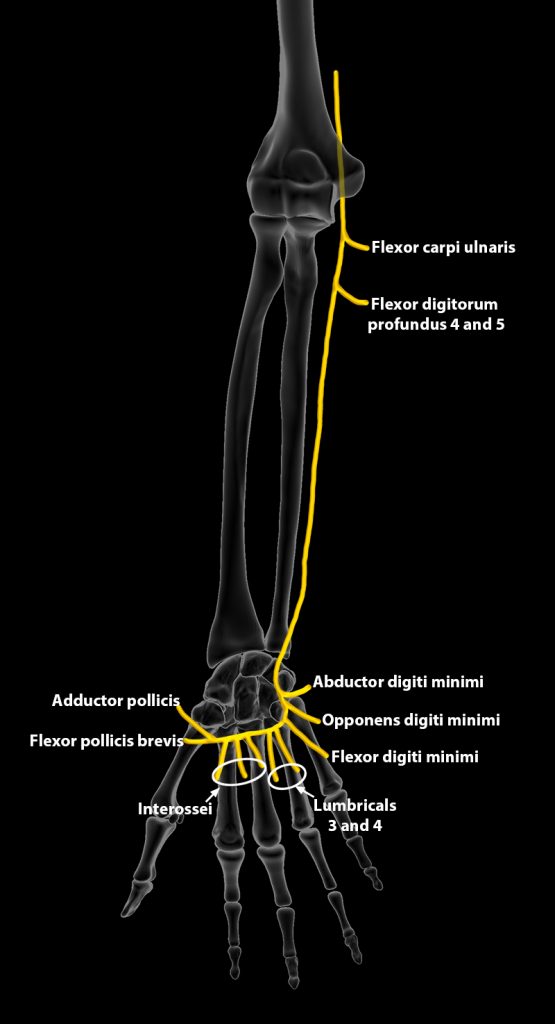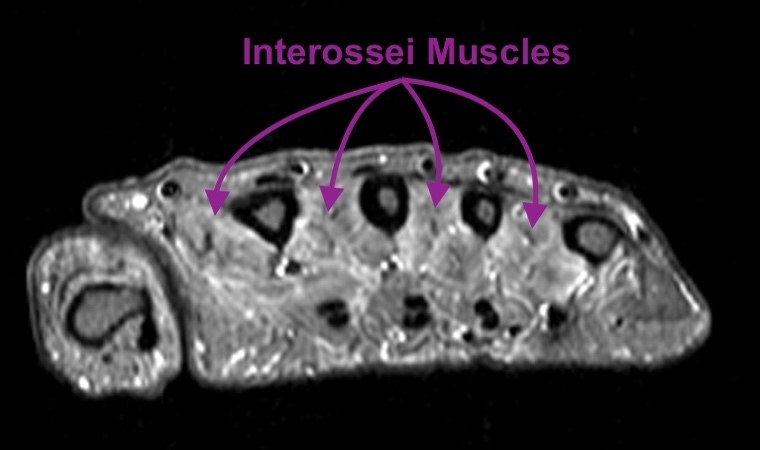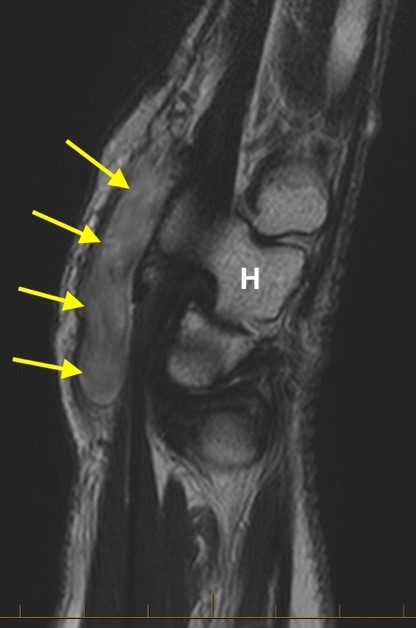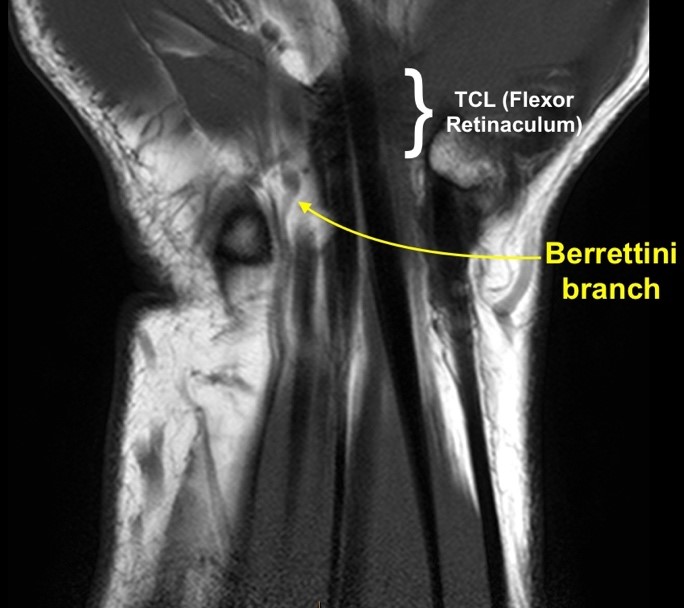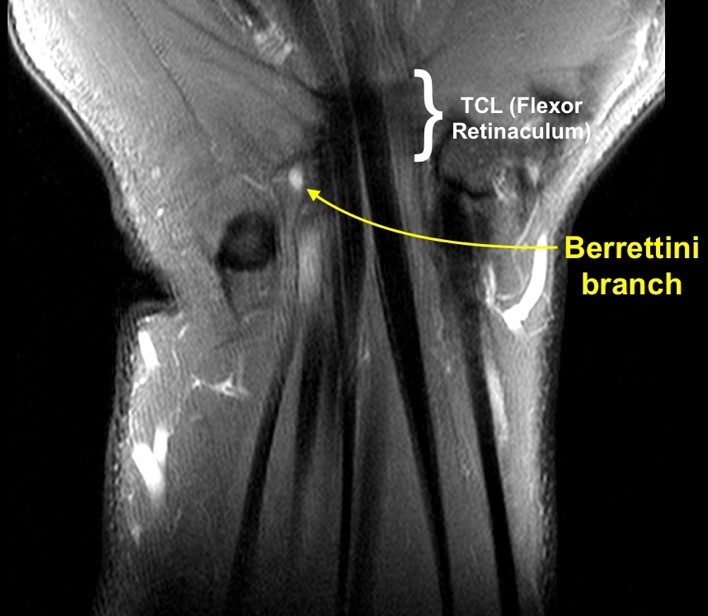Clinical History: A 43-year-old male presents with numbness and tingling along the ring and small finger for 6 weeks with decreased grip strength. Axial fat-suppressed T2-weighted (1A,B) and coronal fat-suppressed T2 (1C) and T1 weighted (1D) images are provided. What are the findings? What is your diagnosis?
Findings
Figure 2:
a: The axial T2 weighted fat-suppressed image at the level of the hamate (H) and trapezium (Tm) demonstrates a lobulated ganglion cyst (blue stars) draping along the distal aspect of Guyon’s canal, abutting the superficial branch of the ulnar nerve, and lying along the hamate hook at the expected location of the deep branch of the ulnar nerve.
b: An additional axial T2 weighted fat-suppressed image at the level of the metacarpals demonstrates denervation muscular edema involving the several muscles innervated by the distal ulnar nerve, including the opponens digiti minimi, flexor digiti minimi brevis, interosssei, and adductor pollicis.
Coronal T2 fat-suppressed (c) and T1-weighted (d) images demonstrates the ganglion cyst (blue stars) extending between the hamate (H) and pisiform (P). The opponens digiti minimi, flexor digiti minimi brevis demonstrate denervation edema and early fatty streaking (curved arrows).
Diagnosis
Guyon’s canal ganglion cyst compressing the superficial and deep branches of the ulnar nerve with associated muscle denervation.
Introduction
Guyon’s canal is an anatomic space along the volar ulnar aspect of wrist which contains distal branches of the ulnar nerve. This web clinic reviews the gross, MRI, and variant anatomy of Guyon’s canal, followed by several pathologic examples and a brief treatment discussion.
Gross Anatomy
The distal ulnar tunnel (aka Guyon’s canal) is a fibro-osseous tunnel in the volar ulnar wrist (figure 3) first described by a French surgeon named Jean Casimer Felix Guyon in 1961. 1 Since Guyon’s original description, additional research and clinical investigations have evolved the distal ulnar tunnel terminology and boundaries into the current anatomic understanding.1,2,3,4 Proximally, the tunnel begins at the proximal edge of the volar carpal ligament, which lies just proximal to the pisiform. Distally, the tunnel extends to the fibrous arch of the hypothenar muscles, which attaches to the hamate. Ulnarly, the tunnel is bound by the flexor carpi ulnaris (FCU) tendon, pisiform, and abductor digiti minimi (ADM), extending from proximal to distal. Radially, the tunnel is bound by the transverse carpal ligament (flexor retinaculum) and hamate. Dorsally, the floor of the tunnel is bound by the flexor digitorum profundus (FDP) tendons, transverse carpal ligament (flexor retinaculum), pisohamate (PH) and pisotriquetral (PT) ligaments, and the opponens digiti minimi (ODM). Volarly, the roof of the tunnel is bound by the volar carpal ligament (proximally) and the palmaris brevis muscle (distally), along with hypothenar fat. It is interesting to note the proximity of the adjacent carpal tunnel, which lies radially separated by the transverse carpal ligament/flexor retinaculum.
In approximately 80% of the population, a distal hiatus within the ulnar tunnel exists near the level of the hamate hook.4 The pisohamate ligament remains at the floor. The roof is formed by a fibrous arch of the hypothenar muscles (abductor digiti minimi, flexor digiti minimi brevis, opponens digiti minimi, and palmaris brevis, listed from medial to lateral), arcading from the pisiform to the hamate. The deep (motor) branch of the ulnar nerve courses deep to this fibrous arch and can be subject to compression.
In 1985, Gross and Gelberman2 proposed a three zone theory of the ulnar tunnel anatomy, based on the branching anatomy of the ulnar nerve (figure 4). This is the most accepted description of the ulnar tunnel and helps explain clinical entrapment symptoms:
- Zone I: Begins from the proximal edge of the volar carpal ligament and ends distally at the bifurcation of the ulnar nerve.
- Zone II: Runs from just distal to the bifurcation of the ulnar nerve to the fibrous arch of the hypothenar muscles and contains the deep (motor) branch of the ulnar nerve.
- Zone III: Begins just distal to the bifurcation of the ulnar nerve and contains the superficial (sensory) branch of the ulnar nerve.
Within the hand, the distal ulnar nerve motor branches extend across an arcade from ulnar to radial (figure 5), first innervating the hypothenar muscles (abductor digiti minimi, opponens digiti minimi, flexor digiti minimi brevis), followed by the 3rd-4th lumbricals, interossei muscles, adductor pollicis, and flexor pollicis brevis.5 Incidentally, the flexor digiti minimi brevis does not typically have a paired longus muscle in humans. If present, the flexor digiti minimi longus is considered an anatomical variant.6
Normal MR Anatomy
On MR imaging, Zeiss et al.7 divided Guyon’s canal into 5 segments including the inlet, proximal, mid, distal, and outlet portions:
The inlet portion of the canal (figure 6a) is located near the distal ulna, with the ulnar nerve located deep and radial to the flexor carpi ulnaris tendon, and ulnar to the ulnar artery and veins.
The proximal canal (figure 6b) is located at the level of the pisiform and corresponds to Zone 1. The proximal canal is typically triangular (base of the triangle adjacent to the pisiform), with average dimensions of 11 mm (transverse) x 7 mm (AP). The boundaries are: pisiform (ulnar), transverse carpal ligament/flexor retinaculum (dorsal), and volar carpal ligament (volar). The ulnar nerve and its branches lie along the ulnar aspect of the canal, with the ulnar artery and veins along the radial aspect.
The mid canal (figure 6c) is located between the pisiform and hamate, triangular or oval, and contains average dimensions of 13 mm (transverse) x 6 mm (AP). The abductor digiti minimi muscle is now visible and the volar carpal ligament has thinned. The ulnar nerve bifurcates into superficial and deep segments. The ulnar artery and veins remain located radial and volarly.
The distal canal is located at (figure 6d) and just distal to the hamate hook (figure 6e), and contains the Zone 2 (deep) and Zone 3 (superficial) branches. The flexor digiti minimi and opponens digiti minimi muscles are now visible. The palmaris brevis muscle replaces the volar carpal ligament as the volar boundary. The fibrous arch of the flexor digiti minimi brevis (FDMB) muscle (or the muscle itself) is located distally, which divides the deep (Zone 2 – motor) and superficial (Zone 3 – sensory) branches of the distal canal and ulnar nerve. The superficial canal is discoid in shape with average measurements of 14 mm (transverse) x 5.5 mm (AP); the deep canal is rounded and smaller.
The outlet portion of the canal (figure 6f) is located distal to the fibrous arch of the FDMB and hamate hook. The superficial ulnar nerve and artery have given digital branches to the small finger and are seen between the palmaris brevis and flexor digiti minimi muscles. The deep ulnar nerve and artery are located within the hypothenar muscles.
Figure 6:
Normal MR anatomy.
6a-f: Progressive axial T1-weighted images demonstrating the inlet (a), proximal (b), mid (c), distal (d,e), and outlet (f) portions.
6g: Coronal T1-weighted image showing the hypothenar muscles, hamate (H) and pisiform (P).
6h: Sagittal T1-weighted image shows the superficial and deep ulnar nerves coursing superficial and deep to the intervening flexor digitorum minimi brevis muscle. The palmaris brevis muscle lies superficial to the superficial ulnar nerve. Note the pisohamate ligament lies dorsal to the deep ulnar nerve. The FCU insertion upon the pisiform is also noted. The triquetrum (T) and ulna (U) are labeled.
Anomalous Muscle Anatomy
Anomalous muscles (figure 7) in the region of Guyon’s canal are common and have been reported to occur in 25% of asymptomatic volunteers, all of which insert with the abductor digiti minimi muscle.7,8 In these patients, bilateral anomalous findings were discovered 67% of the time. Because the prevalence of anomalous muscle anatomy is relatively common and often asymptomatic, it is important to exercise caution in prescribing causation of ulnar nerve compression. Mean anomalous muscle thickness has been reported at 1.7 mm overall, and some authors suggest the thickness of the anomalous muscle may be an important determinant in ulnar nerve compression.9,10 Many different anomalous muscles have been reported around Guyon’s canal, including both extrinsic (flexor digitorum superficialis, abductor digiti minimi, flexor digiti minimi, flexor carpi ulnaris, palmaris longus) and intrinsic (palmaris brevis, flexor digiti minimi, hypothenar adductor) variations.8
Figure 7:
Anomalous Muscles.
7a-d: Axial T1, T2 fat-suppressed, coronal T1, and sagittal T1-weighted images demonstrate an anomalous muscle in continuity with abductor digiti minimi, coursing superficial to the ulnar neurovascular bundle.
7e-f: Axial T1-weighted images in 2 different patients demonstrate anomalous muscles coursing superficial to the ulnar neurovascular bundle near the level of the pisiform.
Pathology
In addition to anomalous muscles, other Guyon’s canal lesions which can entrap the ulnar nerve and result in ulnar neuropathy include ganglion cysts (figures 2,8-9), lipomas (figures 10-11), peripheral nerve sheath tumors (figure 12), ulnar artery aneurysms (figure 13), fractures and dislocations of surrounding bony anatomy such as the pisiform (figure 14), and chronic repetitive trauma such as in cyclist handlebar palsy.11
Clinical symptoms depend on the site of the lesion. Zone 1 (sensory + motor) lesions are the most common, located within the proximal Guyon’s canal, resulting in both ulnar nerve sensory and motor symptoms. Zone 2 (motor only) affect the deep motor branch of the ulnar nerve, and may result in weakness and atrophy of the hypothenar (abductor digiti minimi, opponens digiti minimi, and flexor digiti minimi), flexor pollicis brevis, adductor pollicis, interosseous, and 3rd-4th lumbrical muscles.5 Zone 3 lesions (sensory only) affect the superficial sensory branch of the ulnar nerve and may result in tenderness to percussion over the ulnar nerve at the wrist, and decreased sensation and two-point discrimination at the ulnar aspect of the 4th and 5th fingers.11
On MR imaging, denervation muscle edema (figures 2,8,9) is demonstrated by increased signal on T2-wieghted and STIR sequences, as early as 24-48 hours after denervation, whereas EMG signs may not demonstrate denervation until 2-3 weeks.11 In the acute stage, muscle edema results from capillary enlargement. In the subacute stage, muscle fiber degeneration, development of subsarcolemmal vacuoles, direct neurogenic effects and secondary capillary changes may contribute to neurogenic muscle edema.11 In the chronic stage, fatty muscle atrophy (figure 2d) can occur after several months, manifesting by marbled increased intramuscular signal on non fat-suppressed T1-weighted images.5,11 Additionally, the compressed/entrapped ulnar nerve may itself demonstrate focal enlargement (figure 15), increased T2 signal, and contrast enhancement.11
Figure 8:
Ganglion Cyst – Example 2.
8a-c: Axial T2 fat-suppressed, T1-, and sagittal T2-weighted images demonstrate a ganglion cyst (white arrows) within the distal aspect of Guyon’s canal, draping along the volar and ulnar aspects of the hamate hook, with local mass effect upon the superficial and deep branches of the ulnar nerve.
8d-e: Axial T2 fat-suppressed images demonstrate denervation muscle edema involving distal motor branches of the ulnar nerve, including the interosseous, adductor pollicis, and flexor pollicis brevis muscles.
Figure 9:
Ganglion Cyst – Example 3.
9a-c: Axial fat-suppressed proton density, post IV contrast T1, and coronal fat-suppressed T2-weighted images demonstrate a fluid signal intensity, rim enhancing ganglion cyst (white arrows) along the volar aspect of the distal carpal row, extending distally towards the 3rd and 4th proximal metacarpals, with local mass effect upon the distal branch of the ulnar nerve.
9d: An axial T1-weighted post IV contrast fat-suppressed image demonstrates denervation muscle enhancement involving the distal motor distribution of the ulnar nerve, including the interosseous, adductor pollicis, and flexor pollicis brevis muscles. Denervation muscle edema is also present on the axial fat suppressed proton density-weighted image (9a).
Figure 10:
Lipoma – Example 1.
10a-c: Axial, coronal, and sagittal T1-weighted images demonstrate a circumscribed ovoid area of macroscopic fat signal (white arrows), consistent with a lipoma, extending throughout Guyon’s canal into the proximal forearm.
10d: Lateral view X-ray demonstrates a corresponding fat density radiolucency.
Figure 11:
Lipoma – Example 2.
11a-d: Axial T1, axial T2 fat-suppressed, coronal T1, and sagittal T1-weighted images demonstrate a circumscribed soft tissue mass with macroscopic fat (white arrows), consistent with a lipoma, within Guyon’s canal, wrapping around the hamate (H) extending distally along the volar aspect of the hand. The trapezium (Tm) and first metacarpal (1) are also labeled for reference. The lipoma displaces the ulnar neurovascular bundle, which is displaced ulnarly at the level of the hamate.
Figure 12:
Peripheral nerve sheath tumor (schwannoma).
12a-e: Axial T1 and T2 fat-suppressed, coronal T1 and PD fat-suppressed, and sagittal T2-weighted images demonstrate a circumscribed dumbbell-shaped mass within Guyon’s canal, with decreased T1 signal and heterogeneous increased T2 signal, located medial to the ulnar artery and vein, along the course of the ulnar nerve, consistent with a peripheral nerve sheath tumor (yellow arrows). The pisiform (P) and hamate (H) are labeled for reference.
Figure 13:
Ulnar artery aneurysm.
13a-d: Axial T1 and T2 fat-suppressed, coronal T2 fat-suppressed and coronal T1 weighted images demonstrate a serpentine tubular aneurysmal dilatation of the ulnar artery within Guyon’s canal, located radial to the ulnar nerve superficial branches. The ulnar nerve branches, pisiform (P), and hamate (H) are labeled for reference.
Figure 14:
Subluxation of the pisiform.
14a: Axial T1-weighted image demonstrates an abnormal ovoid elongated appearance of the pisiform (P) with encroachment upon the ulnar nerve within the proximal Guyon’s canal (yellow arrow).
14b: Corresponding sagittal T1-weighted image confirms proximal subluxation of the pisiform with widening along the distal pisotriquetral articulation.
Variant nerve anatomic communications commonly occur between the ulnar and median nerves, such as the superficial palmar communication (Berrettini branch). The Berrettini branch extends from the ulnar nerve, passes through or distal to the transverse carpal ligament, ultimately attaching to the median nerve. This purely sensory branch innervates the ulnar part of the middle finger and radial part of the ring finger. Because of its proximity to the transverse carpal ligament, this variant anatomy can be iatrogrenically injured during endoscopic carpal tunnel release.12 Figure 15 demonstrates an interesting example of an abnormally enlarged and edematous Berrettini branch, consistent with neuritis.
Figure 15:
Variant communicating (Berrettini) branch of the ulnar-median nerve, with neuritis.
15a-d: Progressive axial fat-suppressed T2-weighted images demonstrate a communicating (Berrettini) branch of the superficial ulnar nerve, located along the ulnar aspect of the superficial ulnar nerve. The communicating ulnar nerve branch courses into the carpal tunnel, with abnormal enlargement and increased signal (related to nerve impingement), as it courses through the transverse carpal ligament (15c-d).
15e-f: Coronal T1 and fat-suppressed T2-weighted images confirm focal enlargement of the Berrettini branch. The nerve demonstrates abnormal increased T2 signal (15f) as the it courses through the transverse carpal ligament, entering the carpal tunnel.
Treatment
The treatment of Guyon’s canal pathology is similar to that of carpal tunnel syndrome, and is dependent on the cause, severity, and duration of symptoms. The range of therapy extends from conservative (e.g. rest, splinting, avoidance of chronic repetitive compression motions) to surgery. Moderate to severe symptoms of longer duration may benefit from surgery in which decompression of the canal and excision of any masses (figure 16) can be performed.13 Hand therapy exercises may also be employed postoperatively to help promote range of motion.
Figure 16:
Decompression of Guyon’s canal with a ganglion cyst.
Intraoperative photo of the original unknown case in figures 1-2. An incision has been performed along the volar ulnar aspect of the wrist, with exposure of Guyon’s canal.
16a: The ulnar nerve, ulnar artery, and intact fibrous arch (*) of the hypothenar muscles are demonstrated.
16b: The fibrous arch has been released (double headed arrow), and the ulnar artery is retracted. The deep (motor) branch of the ulnar nerve is now visualized (yellow arrow) and the ganglion cyst is also now visualized (green arrow).
Operative photographs courtesy of Joseph Haber, MD, The orthopaedic Clinic Association, Phoenix, AZ.
Summary
The anatomic understanding of Guyon’s canal has evolved over time and the most currently accepted approach is based on 3 zones of ulnar nerve branching, which parallels the clinical symptoms associated with distal ulnar nerve entrapment. Anatomic variations of the surrounding muscles are common, and several space-occupying lesions can entrap ulnar nerve branches within Guyon’s canal, leading to ulnar sided sensory symptoms and/or distal muscle denervation. In such cases, MRI offers high sensitivity in the identification of relevant pathology, and provides a roadmap to guide treatment decisions.
References
- Maroukis BL, Ogawa T, Rehim SA, Chung KC. Guyon canal: The evolution of clinical anatomy. J Hand Surg Am. 2015. doi:10.1016/j.jhsa.2014.09.026. ↩
- Gross MS, Gelberman RH. The anatomy of the distal ulnar tunnel. Clin Orthop Relat Res. 1985. ↩
- Leversedge FJ, Goldfarb CA, Boyer MI. The Distal Ulnar Tunnel. J Wrist Surg. 2012;1(212):185-186. doi:10.1055/s-0032-1312048. ↩
- Schmidt, H., Lanz U. Surgical Anatomy of the Hand. New York.: Thieme; 2004. ↩
- Kim S-J, Hong SH, Jun WS, et al. MR Imaging Mapping of Skeletal Muscle Denervation in Entrapment and Compressive Neuropathies. RadioGraphics. 2011. doi:10.1148/rg.312105122. ↩
- Greiner TM. An additional flexor of the fifth digit: Flexor digiti minimi longus. Clin Anat. 2008;21(8):792-793. doi:10.1002/ca.20588. ↩
- Zeiss J, Jakab E, Khimji T, Imbriglia J. The ulnar tunnel at the wrist (Guyon’s canal): Normal MR anatomy and variants. Am J Roentgenol. 1992. doi:10.2214/ajr.158.5.1566671. ↩
- Ruocco MJ, Walsh JJ, Jackson JP. MR imaging of ulnar nerve entrapment secondary to an anomalous wrist muscle. Skeletal Radiol. 1998. doi:10.1007/s002560050369. ↩
- Bozkurt MC, Taoỳl SM, Özçakar L, Ostlere S, Harvie P. Re. Prevalence and epidemiological variation of anomalous muscles at Guyon’s canal. Harvie P, Patel N, Ostlere SJ (2004) Journal of Hand Surgery, 29B:26-29 (multiple letters) (2). J Hand Surg Am. 2004. doi:10.1016/j.jhsb.2004.06.010. ↩
- Blum AG, Zabel J-P, Kohlmann R, et al. Pathologic Conditions of the Hypothenar Eminence: Evaluation with Multidetector CT and MR Imaging. RadioGraphics. 2006. doi:10.1148/rg.264055114. ↩
- Andreisek G, Crook DW, Burg D, Marincek B, Weishaupt D. Peripheral Neuropathies of the Median, Radial, and Ulnar Nerves: MR Imaging Features. RadioGraphics. 2006. doi:10.1148/rg.265055712. ↩
- Stančić MF, Mićović V, Potoćnjak M. The anatomy of the Berrettini branch: implications for carpal tunnel release. J Neurosurg. 1999. doi:10.3171/jns.1999.91.6.1027. ↩
- Aleksenko D, Dulebohn SC. Guyon Canal Syndrome. StatPearls. 2017;3:1-5. http://www.ncbi.nlm.nih.gov/pubmed/28613717. ↩












